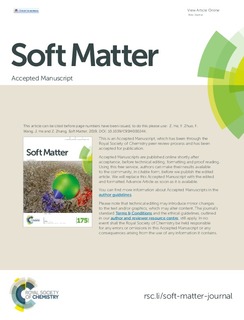| dc.contributor.author | He, Zhiwei | |
| dc.contributor.author | Zhuo, Yizhi | |
| dc.contributor.author | Wang, Feng | |
| dc.contributor.author | He, Jianying | |
| dc.contributor.author | Zhang, Zhiliang | |
| dc.date.accessioned | 2019-04-02T08:06:59Z | |
| dc.date.available | 2019-04-02T08:06:59Z | |
| dc.date.created | 2019-02-28T11:00:54Z | |
| dc.date.issued | 2019 | |
| dc.identifier.issn | 1744-683X | |
| dc.identifier.uri | http://hdl.handle.net/11250/2592844 | |
| dc.description.abstract | The accretion of ice on exposed surfaces infers detrimental effects on many aspects of life and technology. Passive icephobic coatings, designed by strategies towards lowering ice adhesion to mitigate the icing problems, have recently received wide attention. In our previous studies, the incorporation of hollow sub-surface structures which act as macro-scale crack initiators has been shown to dratically lower the ice adhesion on PDMS surfaces. In this study, the effects of hollow sub-surface structure geometry, such as the heights, shapes, and distributions, as well as directions of the applied shear force, are experimentally investigated. Our results show that the number of potential macro-scale crack initiation sites dictates ice adhesion strength. Directions of the applied shear force also influence ice adhesion strength when the potential crack length is dependent on the applied shear force direction. The inter-locking effect between ice and the coating, caused by the pre-deformation, needs to be considered if one of the dimensions of the hollow sub-surface structures approaches millimeter scale. These results improve the understanding of the role of hollow sub-surface structures in reducing ice adhesion, providing new insights on the design principles for multi-scale crack initiators promoted icephobic surfaces. | nb_NO |
| dc.language.iso | eng | nb_NO |
| dc.publisher | Royal Society of Chemistry | nb_NO |
| dc.title | Understanding the role of hollow sub-surface structures in reducing ice adhesion strength | nb_NO |
| dc.type | Journal article | nb_NO |
| dc.type | Peer reviewed | nb_NO |
| dc.description.version | acceptedVersion | nb_NO |
| dc.source.journal | Soft Matter | nb_NO |
| dc.identifier.doi | 10.1039/C9SM00024K | |
| dc.identifier.cristin | 1681263 | |
| dc.relation.project | Norges forskningsråd: 245963 | nb_NO |
| dc.relation.project | Norges forskningsråd: 250990 | nb_NO |
| dc.description.localcode | © 2019. This is the authors' accepted and refereed manuscript to the article. Locked until 27.2.2020. The final authenticated version is available online at: http://dx.doi.org/DOI | nb_NO |
| cristin.unitcode | 194,64,45,0 | |
| cristin.unitname | Institutt for konstruksjonsteknikk | |
| cristin.ispublished | true | |
| cristin.fulltext | postprint | |
| cristin.qualitycode | 2 | |
